Dell XPS 410: Core 2 Duo for the Masses
by Jarred Walton on September 18, 2006 12:20 PM EST- Posted in
- Systems
Externals and Appearance
We said that the 2407WFP display is probably the most impressive part of the configuration we were sent for testing. However, the system design is really good as well. Almost everything is completely tool-less, and accessing the internals and changing components is extremely easy. Let's start with the outward appearance first.
In a break from tradition, the case is all white with the Dell logo embossed on the sides. After seeing many beige, black, and varying other colors of cases, the pure white design is a nice change. Some might say that Dell seems to be copying the white appearance of Apple's iMac computers, but if you are looking to copy aesthetics there are far worse choices than Apple.
The front panel is a more traditional design, with black drive bays set in a silver mold. At the top of the case is a chrome XPS 410 logo, and at the bottom are the air intakes for one of the internal fans. Above the Dell logo, you can see the power switch, and you also have access to the front audio ports, two USB ports, and a FireWire port (provided you get the optional FireWire PCI card).
The left and right sides of the case are virtually mirror images of each other. The only difference is that the right side has some ventilation slots at the bottom of the case. If you're wondering about the black cutout towards the front of the case, that is part of the BTX design Dell has used. This provides an air intake for the main 120mm fan that cools the CPU heatsink and also provides ventilation to the inside of the case. Some form of ducting could have been used instead, so the cutout seems to be more for adding visual flair than because it was absolutely required.
Besides the typical connectors you would find at the rear of any PC, there are a few interesting points about the Dell XPS 410. First, note how there's a huge ventilated area in the middle section of the case. This matches up with the 120mm fan located at the front of the case, with the CPU heatsink sitting in the middle. Basically, this provides a great way for getting all of the hot air generated by the CPU and other components out of the system. You can also see that the standard I/O panel is dramatically different from what most people are used to. There are no PS/2 keyboard or mouse ports, nor are there serial or parallel ports. Instead, you get six USB 2.0 ports, a Gigabit Ethernet port, and an S/PDIF optical out connection. Above the S/PDIF port are the audio ports, which are hidden by a small cover by default. If you use the system as an entertainment center PC, the optical out would be the preferred connection, though most people will more than likely use analog speakers.
The last two items worth noting on the rear of the case are better viewed from a different angle. At the top you can see the latch that pops open the right side of the case. This makes it extremely easy to open up the system for upgrades or maintenance. At the bottom just above the expansion card slots you can see a protruding hinge. We will take a closer look at how this works when we get to the internals next, but basically it's part of the tool-less design that allows you to install or remove expansion cards very easily.
We said that the 2407WFP display is probably the most impressive part of the configuration we were sent for testing. However, the system design is really good as well. Almost everything is completely tool-less, and accessing the internals and changing components is extremely easy. Let's start with the outward appearance first.
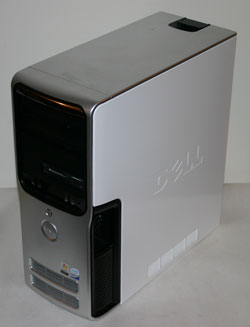 |
| Click to enlarge |
In a break from tradition, the case is all white with the Dell logo embossed on the sides. After seeing many beige, black, and varying other colors of cases, the pure white design is a nice change. Some might say that Dell seems to be copying the white appearance of Apple's iMac computers, but if you are looking to copy aesthetics there are far worse choices than Apple.
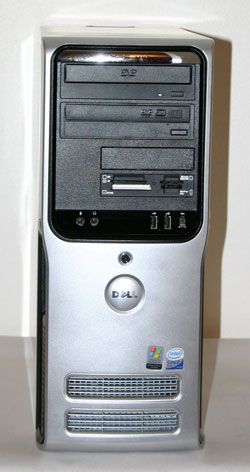 |
| Click to enlarge |
The front panel is a more traditional design, with black drive bays set in a silver mold. At the top of the case is a chrome XPS 410 logo, and at the bottom are the air intakes for one of the internal fans. Above the Dell logo, you can see the power switch, and you also have access to the front audio ports, two USB ports, and a FireWire port (provided you get the optional FireWire PCI card).
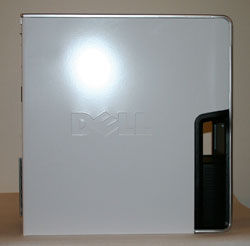 |
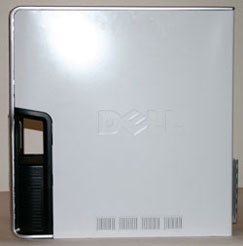 |
| Click to enlarge | |
The left and right sides of the case are virtually mirror images of each other. The only difference is that the right side has some ventilation slots at the bottom of the case. If you're wondering about the black cutout towards the front of the case, that is part of the BTX design Dell has used. This provides an air intake for the main 120mm fan that cools the CPU heatsink and also provides ventilation to the inside of the case. Some form of ducting could have been used instead, so the cutout seems to be more for adding visual flair than because it was absolutely required.
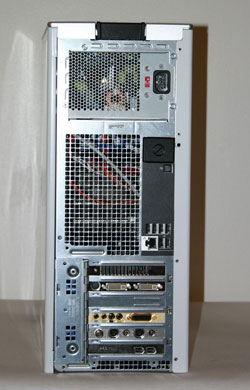 |
| Click to enlarge |
Besides the typical connectors you would find at the rear of any PC, there are a few interesting points about the Dell XPS 410. First, note how there's a huge ventilated area in the middle section of the case. This matches up with the 120mm fan located at the front of the case, with the CPU heatsink sitting in the middle. Basically, this provides a great way for getting all of the hot air generated by the CPU and other components out of the system. You can also see that the standard I/O panel is dramatically different from what most people are used to. There are no PS/2 keyboard or mouse ports, nor are there serial or parallel ports. Instead, you get six USB 2.0 ports, a Gigabit Ethernet port, and an S/PDIF optical out connection. Above the S/PDIF port are the audio ports, which are hidden by a small cover by default. If you use the system as an entertainment center PC, the optical out would be the preferred connection, though most people will more than likely use analog speakers.
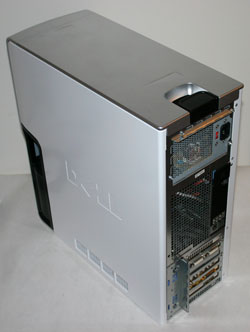 |
| Click to enlarge |
The last two items worth noting on the rear of the case are better viewed from a different angle. At the top you can see the latch that pops open the right side of the case. This makes it extremely easy to open up the system for upgrades or maintenance. At the bottom just above the expansion card slots you can see a protruding hinge. We will take a closer look at how this works when we get to the internals next, but basically it's part of the tool-less design that allows you to install or remove expansion cards very easily.










50 Comments
View All Comments
JarredWalton - Tuesday, September 19, 2006 - link
No problem - gotta do my job as author! :)You might want to email Gary on the HDD stuff, as that's basically beyond the scope of system testing. He's handling HDD reviews, so maybe you can pass on your suggestions. I think he's covered HDD performance well, though getting repeatable results with real world tests is going to be somewhat difficult.
JarredWalton - Monday, September 18, 2006 - link
^^ Er..."defragment" not "the fragment"
*EIGHT* thousand words, not "a thousand".
LOL Stupid Dragon NaturallySpeaking! (Stupid editor for not proofing my post before hitting reply.)
biggersteve - Monday, September 18, 2006 - link
An amazing story. XPS has a special support number 800-999-3355. We called this number and the guy in India was pretty efficient and helpful. XP had died with a reboot loop. Could not even safe boot. The guy advised us to use ctl-F11 to completely erase the HD and start over. We'd only had it a week so that was ok, though I suspect we could have done a roll-back, though we couldn't even safe boot. Anyway, all this happened after Microsoft helpfully installed 37 automatic updates. The guy at Dell said half the calls they're getting are because of this. (The other half must be the battery recall...) So he told us to turn off Windows Automatic Updates and never ever ever use it again. I only have one data point, but it looks like Microsoft released an automatic update that whacks all the XPS 410's out there and maybe more. So now we have a standoff where Dell is telling everyone to never use Microsoft automatic updates. Who wins? The virus and spyware writers. And Apple... since Apple controls the hardware and OS alike, they'd never release a cluster-fsck like this one.yyrkoon - Monday, September 18, 2006 - link
well, this should be obvious, but the person who told you to turn off windows automatic updates, and to 'never ever ever turn it on again' is an idiot. Sounds like either you had/ have spyware, or a virus, OR, you installed a hardware update from MS, instead using Dells drivers. I have personally run into 'MS certified drivers' issues with Dell systems in the past (more than once). I dont own a Dell myself, but the majority of our customers, that want a prebuilt in-expencive systems, we recommend to buy from Dell, so we do see our share of them.My recommendation, would be to USE automatic updates, but instead of having it download, and install the updates for you, configure it to notify you only, then you can manually download, and install yourself. When installing the updates, make sure to choose 'custom', and read what each update is all about. 9 times out of 10, if it isnt a critical update, or a security fix, you dont need it.
mino - Tuesday, September 19, 2006 - link
Agreed on the auto-off stuff.However it is possible some MS priority update will not like some HW/drivers even WHQL-ed ones. Compatibility is the word. Windows world is simply too diverse to check all of the possibilities.
mino - Monday, September 18, 2006 - link
Experienced such a story many times... SP2, .NET 2.0, specific "hot-fix" ...Cynic would say "Welcome to the world of Windows!". ;(
JarredWalton - Monday, September 18, 2006 - link
Interesting. I did download and apply all of the currently available patches from Microsoft without any problems. Note that I downloaded these manually rather than letting Windows do the patch automatically during the night. I don't know if that would make a difference, but I don't particularly like having the automatic update process running all the time.mino - Tuesday, September 19, 2006 - link
Most of the times things work, the problem are the situations when they do not.Not once have I had to spend a day installing a few updates a time, just to find out which one was incompatible .. so that some Windows feature would work.
Pastuch - Monday, September 18, 2006 - link
I am actually a Dell employee at their technical support centers in Ottawa Ontario Canada. I can say with all honesty that if you get anyone in north america youll probably get great support. The problem is that Dell phone support has a large number of different queues and our customers tend to get bounced around quite a bit. The company is really trying to improve their customer service which is why they have moved most of their tech support to Canada. If you know someone that isnt tech savy they have the option of buying a "Dell on Call" plan. This is an annual plan or single incident that provides support for pretty much anything. If you are going to get a Dell you can get a 30day trial of DOC (Dell on Call) support with your system. A typical DOC call will have the agent remotely connect to your computer and show you the basics of spyware/adware prevention, updates, system maintenance , etc. I have been an Anand reader for years and I think the type of people likely to buy this PC would benefit from Dell on Call software support. I actually worked in DOC for the last 6 months and was resently promoted to IT operations for the building here in Ottawa.For the record: I've never bought a dell and I'll continue to build all my PCs from scratch and overclock the $hit out of them. Nothing like taking an Opteron 146 (2.0) to 2.8 on AIr!
P.S. In the next year you will be able to get almost any of our machines with AMD or Intel chips. I was one of the thousands of Dell employees that have been pushing for this for a long time. ;)
regpfj - Monday, September 18, 2006 - link
To Jarred - great review, nice job. I liked the discussion of the case features and proprietary motherboard. It's fun to see a legacy-free setup, although serial and IDE have their place too. These unusual things make Dell stuff a bit more interesting to read about.On to my question -
On page 9, the fps vs resolution graphs confused me a tiny bit. For all games except Bf2, performance is a bit lower at 1600 x 1200 than at 1680 x 1050. I think 16x12 is about 9% more pixels than 16.8 x 10.5, right? So is Bf2 just weird, or did the numbers get turned around a bit?